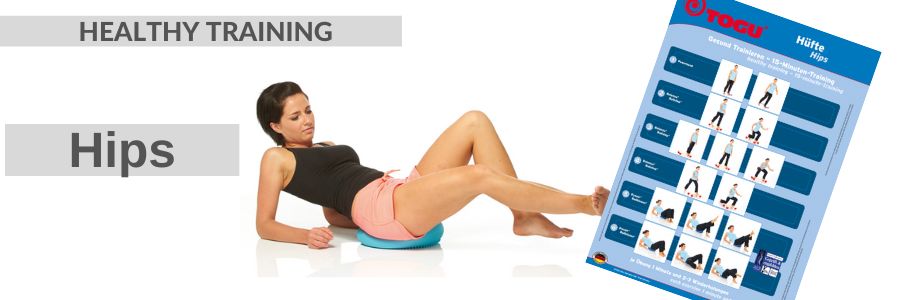What are the functions of the hip joint and the hip muscles?
The hip joint is the second largest joint in the human body and plays a crucial role in our mobility and mobility. It connects the thigh bone to the pelvis and enables complex movements such as walking, running, bending and twisting.
To make these movements possible, several muscles around the hip joint work together. The large lumbar muscle, also known as the hip flexor, is located at the front of the thigh and is responsible for bending the trunk. It also plays an important role in lifting the leg forward.
The iliac muscle, also known as the hip abductor, runs along the outside of the hip joint. It is responsible for lifting and splaying the leg to the side. This muscle is especially important for lateral stability and alignment of the hip.
In addition to these muscles, there are other hip muscles that support and stabilize the hip joint. These include the gluteus maximus, which is responsible for hip extension and external rotation, and the hip adductor, which pulls the leg toward the center of the body. These muscles work together to ensure optimal functionality of the hip joint.
What are the benefits of hip training?
Hip training offers a variety of health and wellness benefits. Here are some of the most important benefits:
• Stability and mobility: Targeted hip training strengthens the muscles around the hip joint, thereby improving
the stability of the entire body. A strong hip makes it possible to perform movements such as walking, running and bending in a controlled
and coordinated.
• Injury prevention: By training the hip muscles, muscular imbalances can be corrected. This
reduces the risk of injuries, especially in the hip, lower back and legs. A strong
hip also helps prevent falls in everyday life, especially in older people.
• Improved posture: Strong hip muscles support correct posture. Through hip training
muscular imbalances are reduced and the spine can be kept in a neutral position. This contributes
to the prevention of back pain and other postural problems.
• Performance enhancement in sports and fitness: A strong hip is crucial for many sports and activities.
importance. It improves performance in running, jumping, tennis, soccer and other sports that
require good hip stability and mobility.
• Rehabilitation support: Hip training can also help with rehabilitation after injury or surgery to the
hip area. Through targeted exercises, muscles can be built up, movement restrictions improved and
recovery can be accelerated.
• Promotion of health in old age: A strong hip is particularly important for staying fit and mobile in old age.
Regular hip training can prevent or reduce age-related complaints such as joint stiffness, back pain and
limited mobility can be prevented or reduced.
It is important to note that hip training should be individualized to meet the specific needs and abilities of each person. It is recommended to work with a qualified trainer or physiotherapist to develop a customized training program.
How to train the hip muscles and stretch the hip?
You can effectively exercise the hip muscles and stretch the hip to improve its stability and mobility. Here are some exercises and stretches you can try:
Hip muscle training:
• Squats: Perform squats to strengthen the hip flexors, glutes and hamstrings. Make sure,
your knees don't go past the tips of your toes, and keep your back straight.
• Lunges: Do lunges forward or to the side to work your hip flexors, glutes and hamstrings.
muscles. Keep your torso upright and bend your front knee while lowering your back knee.
Side leg raises: Raise one leg to the side to strengthen your hip abductors. Stand
sideways to a wall or chair back to maintain balance.
• Leg and hip flexor stretching: Lie on your back and pull one knee toward your chest. Keep the other leg straight on the floor.
the floor. Hold the position for about 30 seconds and then switch sides. This stretch targets the hip flexors and glutes.
gluteal muscles.
• Butterfly stretch:Sit on the floor, bring the soles of your feet together and pull them as close to your body as possible.
body as possible. Press lightly on the knees to feel a stretch in the hip muscles.
• Piriformis stretch: Sit on the floor, bend one leg and place the foot of the bent leg on the other knee. Pull
the bent leg slowly to the chest to stretch the piriformis muscle. Hold the position for about 30 seconds and then
then switch sides.
Hip Stretch:
During all exercises and stretches, make sure to work slowly and in a controlled manner. Breathe in and out calmly and deeply during the movements. Begin with a light warm-up before you start exercising or stretching to avoid injury.
Remember that it is important to listen to your body and only do what is comfortable for you. If you feel pain or discomfort, you should stop the exercise and seek professional advice if necessary.
How can balance training help with hip training?
Balance training with TOGU exercise equipment and programs can make a significant contribution to hip health. Strengthening the hip and pelvis for the stability and mobility of the entire body of great importance, especially in advanced age. Balance training is not only a training of balance ability, but also of strength and sensorimotor functions.
The training equipment from TOGU, such as the air-filled and therefore unstable pads, provide the ideal basis for balance exercises. Training on these unstable pads not only improves balance and hip stability, but also trains the nervous system and deeper muscles. This has positive effects on the mobility and stability of the joints.
What is the Healthy Training Concept from TOGU?
The genius of the Healthy Training concept from TOGU lies in the optimal combination of high-quality training equipment and the ease of implementation for the patient. In addition, the exercises are specially tailored to individual needs and wishes. This makes the training possible for people of all ages and can be adapted to the respective requirements.
Whether you use the program for prevention or become active after health problems have occurred, it is always advisable to ask your doctor or physiotherapist for advice if you have any complaints. The Healthy Exercise Concept of TOGU offers you a self-reliant solution that you can carry out in everyday life as a supplement to therapeutic treatment.
Frequently asked questions about hip training
How often should I do my hip training?
It is recommended to exercise the hip muscles two to three times a week to achieve good results.
Can I do hip training at home?
Yes, there are many simple exercises you can do at home without special equipment, such as leg raises while lying down or bridge.
What is the role of balance training for the hip?
Balance training not only strengthens the hip muscles, but also improves hip stability and coordination.
Can hip training help with hip pain?
Yes, targeted hip training can help strengthen the muscles around the hip and relieve pain.
Can I also train the hips as a woman?
Yes, as a woman, you can definitely train your hips to improve their strength and flexibility and to build muscle.
Can I train a wide hip?
Exercising can help strengthen the muscles around the hip and improve its shape, but it's important to note that genetic predisposition and bone structure also play a role in hip width.
How long does it take for me to see improvements in hip training?
Results may vary from individual to individual, but regular hip training over several weeks can lead to noticeable improvements.
Is hip training also suitable for older people?
Yes, hip training is suitable for people of all ages and can help maintain hip mobility and stability, especially as we age.
What are the benefits of hip training for athletes?
Strong hip training improves performance and stability during athletic activities such as running, jumping and soccer.













